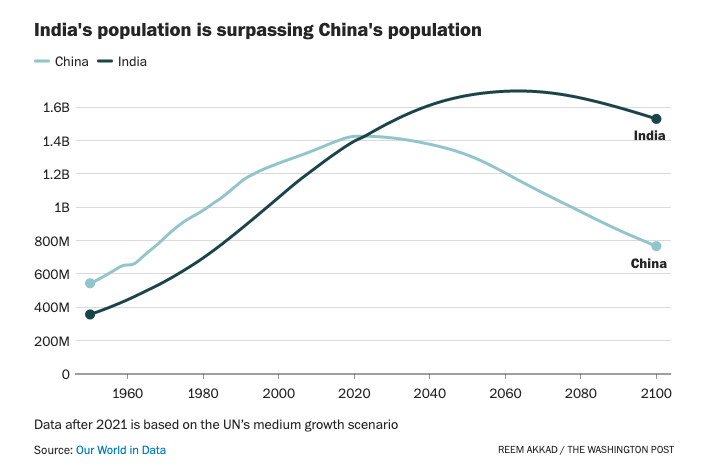India's population has surpassed China's to become the world's largest, sometimes this early April 2023 according to recent estimates.
India's population is estimated to be around 1.4 billion, very slightly above China's. This represents a significant shift in the global balance of power, as China has held the title of the world's most populous country for several decades.
This shift is not just about numbers, but also about economic and political influence. This is likely to have significant implications for the global economy, as India is one of the fastest-growing economies in the world.
India's growing population is also likely to have implications for the ASEAN region, which includes countries such as Indonesia, Malaysia, Thailand, and Vietnam. As India's economy grows, it is likely to become a major trading partner for many ASEAN countries, which could drive economic growth and development in the region.
However, India's growing population also poses challenges related to resource scarcity, environmental degradation, and social and economic development. For example, India is already facing water scarcity in many parts of the country, which is likely to become more acute as the population grows.
Moreover, India's growing population is likely to put increasing pressure on natural resources such as forests, fisheries, and minerals. This could lead to environmental degradation and conflict over access to resources, particularly in regions where natural resources are scarce.
India's growing population is also likely to exacerbate social and economic inequalities. For example, India has one of the highest rates of income inequality in the world, with a significant proportion of the population living in poverty. As the population grows, it is likely that these inequalities will become more pronounced, unless action is taken to address them.
To address these challenges, it is essential to focus on sustainable development, improving access to education and healthcare, and fostering cooperation and collaboration across multiple sectors and stakeholders. By doing so, we can build a more equitable, prosperous, and sustainable future for everyone.
One way to address these challenges is through sustainable development. This involves finding ways to meet the needs of the present without compromising the ability of future generations to meet their own needs. This could involve investing in renewable energy sources, reducing waste and pollution, and promoting sustainable agricultural practices.

Another approach is to focus on improving access to education and healthcare. By investing in these areas, India and other countries can help ensure that their citizens have the knowledge and skills needed to thrive in a rapidly changing world.
Finally, it is essential to recognize that addressing the challenges posed by India's growing population will require a coordinated effort across multiple sectors and stakeholders. Governments, civil society organizations, and the private sector will all need to work together to develop and implement solutions that benefit everyone.

In conclusion, India's population surpassing China is a significant milestone with far-reaching implications. While it presents opportunities for economic growth and collaboration, it also poses challenges related to resource scarcity, environmental degradation, and social and economic development.
As India and other countries work to address these challenges, it is essential to focus on sustainable development, improving access to education and healthcare, and fostering cooperation and collaboration across multiple sectors and stakeholders. By doing so, we can build a more equitable, prosperous, and sustainable future for everyone.
References:
- "India Now Has More People Than China." Wall Street Journal, 16 July 2021, https://www.wsj.com/articles/india-china-population-economy-9dd7bf27.
- "World Population Prospects 2019." United Nations, https://population.un.org/wpp/.
- "India's Water Crisis: Causes and Challenges." World Resources Institute, 10 June 2019, https://www.wri.org/blog/2019/06/india-water-crisis-causes-and-challenges.
- "India's Population Explosion: Causes and Consequences." The Diplomat, 20 Oct. 2021, https://thediplomat.com/2021/10/indias-population-explosion-causes-and-consequences/.
- "India's Inequality Predicament." The Diplomat, 23 Sept. 2021, https://thediplomat.com/2021/09/indias-inequality-predicament/.



















